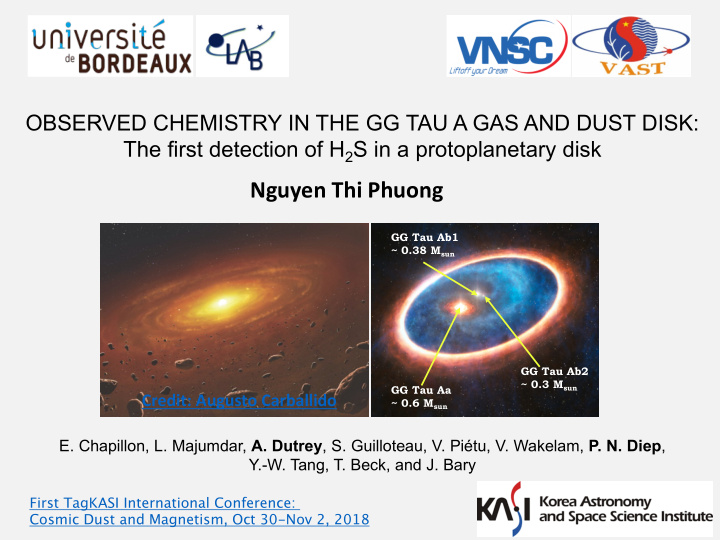



OBSERVED CHEMISTRY IN THE GG TAU A GAS AND DUST DISK: The first detection of H 2 S in a protoplanetary disk Nguyen Thi Phuong GG Tau Ab1 ~ 0.38 M sun GG Tau Ab2 ~ 0.3 M sun GG Tau Aa Credit: Augusto Carballido ~ 0.6 M sun E. Chapillon, L. Majumdar, A. Dutrey , S. Guilloteau, V. Piétu, V. Wakelam, P. N. Diep , Y.-W. Tang, T. Beck, and J. Bary First TagKASI International Conference: 1 Cosmic Dust and Magnetism, Oct 30-Nov 2, 2018
CONTENTS Introduction Observations and results Discussion Summary 2
Introduction Observed molecular lines in GG Tau A GG TAU A , a typical T Tauri star Taurus-Auriga star forming region 140 pc, 2-3 Myr A triple system, Cavity of 180 au, i~ 37 o , PA ~8 o M ✮ =1.3 M ⦿ , M disk = 0.12 M ⦿ Gas + dust disk out to 800 au Dutrey et al, 2016 Velocity map Dust ring of 180 – 260 au at ~ 3–4 scale heigh ts Observed continuum emission in GG Tau A at midplane 3
Observations and results (S-bearing species) In recent attempt to study molecular chemistry with focus on Sulfur-bearing species, we observed CS, H 2 S, SO, SO 2 and CCS in the GG Tau A disk. H 2 S Phuong et al., 2018 CS (3-2) and CS (7-6) are observed in the disk, with CS (3-2) is more extended and CS(7-6) mostly present in the dense ring region. Most of the H 2 S 1(1,0) –1(0,1) emission originates from the dense ring between 180 and 260 au (T ~25 K) and extends up to ~500 au. Other Sulfur-bearing species SO, SO 2 , which are expected to be in the warmer region of the disk and C 2 S are not detected. 4
Observations and results (C-bearing species) Some Carbon-bearing molecules were also observed. HCO + (1–0) is as extended as the CO emission out ~800 au H 13 CO + (2–1) isotopologe emission peaks in the eastern part of the ring. DCO + (3–2) emission peaks outside of the dense ring. H 13 CO + DCO + HCO + Phuong et al., 2018 The measured HCO + /H 13 CO + ratio is ~30, suggesting partially optically thick emission for HCO + (1–0) line. 5
Observations and results (C-bearing species) Precursors of DCO + and HCO + are H 2 D + , H 3 + and CO H 2 D + + CO à DCO + + H 2 + + CO à HCO + +H 2 H 3 H 2 D + formed in the gas phase at low temperature, easily destroyed by CO, N 2 H 3 + + HD ⇆ H 2 D + + H 2 +232K à H 2 D + should be abundant in cold disk mid-plane and studing DCO + may give evidence for the CO snow line in disk mid-plane. The measured DCO + /HCO + ratio in disks: 0.03 over the GG Tau A disk – This work 0.04 in the disk of TW Hydra (0.06 M ⦿ ) – van Dishoeck et al. 2003 0.024 in the disk of LkCa 15 (0.0 28 M ⦿ ) – Huang et al. 2017 à This is consistent with other disks and gives clear evidence of ongoing deuterium enrichment in the GG Tau A disk. 6
Observations and results We use three-phase (i.e., gas phase, grain surface, and grain mantle, along with possible exchanges between the different phases) chemical model Nautilus to model the chemistry in the dense and cold ring of GG Tau A in order to explain the observations. – C/O ratio affects the abundances of SO, SO 2 : Their column densities drop by factors of 100 and 500, respectively, when C/O changes from 0.46 to 1.2 (Semenov et al. 2018) – UV field has a negligible impact on the H 2 S desorption and mild affects to the SO/H 2 S ratio and small affects to the DCO + /HCO + ratio. – 2 grain size model produces much higher H 2 S than observed. Final compromised parameters For CS: CD (Observed) /CD (Predicted) ~ 2 One grain size model of 0.1 𝜈 m Stellar UV flux of f UV200AU = 375 𝜓 0 For DCO + and HCO + : CD (Observed) /CD (Predicted) ~ 5 –7 The standard C/O ratio of 0.7 Sulfur abundance of 8 10 –8 But over-predicted for H 2 S (grain surface formation species) : CD (Observed) /CD (Predicted) ~ 26 7
Discussion Comparison with other sources Kraus & Ireland 2012 The disks appear to have very similar relative abundances, suggesting similar chemical processes at play, while the dense core differs significantly. The H 2 S column density is about 3 times greater than the upper limits for DMTau, MWC480, GOTau, and LkCa 15 (Dutrey+2011), probably reflecting the larger disk mass of GG Tau A. The CS to H 2 S abundance ratio of 20 in GG Tau A may still be similar in all sources. 8
Summary § We report the first detection of H 2 S in a protoplanetary disk and the detections of HCO + , H 13 CO + , DCO + . § Our three-phase chemical model fails to reproduce the observed column densities of S-bearing molecules, except for CS, suggesting that our understanding of Sulfur chemistry is still incomplete. § Comparisons with other disks indicate that the detection of H 2 S appears to be facilitated by the large disk mass, but that the relative abundance ratios remain similar. This indicates that GG Tau A could be a good test bed for chemistry in disks. Thank you for your attention! 9
Recommend
More recommend